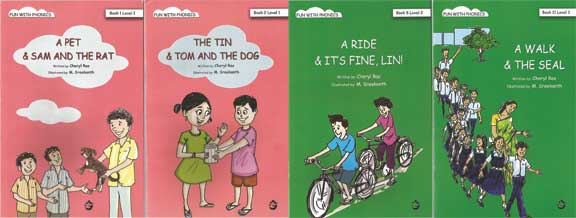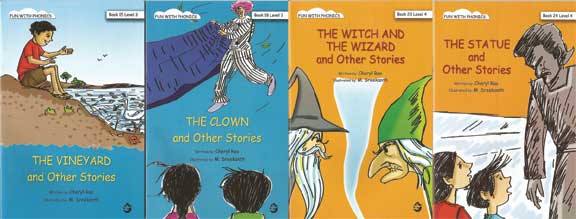Manaswini Sridhar
Our brains are wired to acquire any language when given adequate exposure to it. Reading, on the other hand, requires greater application and support, and hence writers resort to diverse methods to motivate and encourage children to read with the aid of appealing pictures, large fonts, vibrant colours, rhyme and rhythm, and everything else imaginable to narrate simple and yet fun stories about people, animals and events.
Fun with Phonics is a set of 24 books divided into four levels of reading for convenience and practicality. The pleasantly coloured paperback covers in pink, green, blue and yellow differentiate the four levels visually for young readers. The books with large, appealing black-and-white illustrations are Indian – something that the child can relate to and recognize. The inside cover outlines information on the sounds introduced at each level, explaining that the same letter with a different sound is not used with the stories until the child becomes completely familiar with the various sounds of each letter. There is also a note to parents and teachers on how to use the books to help children begin their reading journey.

Each story labels the sound or sounds introduced in the story in a box, together with the sight words that are difficult to decode for the early reader. The short, phonic stories in the lower levels enable the child to read simple sentences. Here, there are no more than 15 sentences in each story, making it easier for the early reader to tackle, and giving the child a sense of achievement at the end of the story. The stories then become slightly longer, steadily challenging the young reader by introducing more and more sounds in longer sentences. However, the font size and the number of illustrations remain the same, since the author intends to handhold the child across all the levels.
Most of the stories are clearly racy, and the author, being a children’s writer, has used her creativity to conjure up a variety of rhyming words from the given sound or sounds, to string together a narrative. The repetitiveness of the sound and sometimes of the words themselves make the narratives playful and zestful, in sentences such as:
The cat ran to the van. The rat ran to a cap in a can. The cat ran to the can. The rat in the cap ran to a man on a mat. (Level 1, Book 1)
In this instance, the short vowel a is introduced, and the child practises the sound in the form of a story. This kind of patterning helps early readers decode the words without making it seem like a drill.
The text, across all the 24 books is large, and the ample white space around the text makes it less overwhelming for the young reader. The author has borne in mind that reading a packed text does not come naturally and needs practice. Hence the text and the pictures are distinct from one another so that the child can easily focus on both aspects of the story. Single quotes have been used to mark conversation so that young readers are not too distracted.
The short vowel sounds are introduced first, the short e being the first sound introduced. The rhyme and rhythm of the words make it significantly easy for the child to decode the words, as in ‘Let’s get a pet,’ says Ted.
A, and, says are introduced as sight words on top of the page, so the adult guiding the child, would point this out, and the child would get into the practice of recognizing it as such. Although the story is woven around the short e, other vowel sounds, particularly the long ones (as in go) also find their way in Level 1 Book 1 along with words like on and of that could have also been listed as sight words. Again, on page 5, the short u is introduced in the word Mum. Long vowel sounds that are listed to appear in Level 2, make their appearance in Level 1 itself (tape as opposed to tap). This probably happens because the stories rely heavily on rhyme and rhythm. Again, the listing of the sight words is not comprehensive. This could result in the child starting to guess the words, which may lead to incorrect reading and therefore poor comprehension. Given the fact that many young children have difficulty with reading, and in many cases, the child wades through the books either only in school or independently, it could create a few hiccups.

Some of the stories, such as Brenda’s Bracelet in Book 22, and The Mare, the Hare and the Bear in Book 17 are bound to delight the child and help learn the sounds. The author has dealt with consonant blends and double vowel sounds with creativity. At other times, in an attempt to rhyme and to create a beat, Indianisms have crept in, as in the title of the story The Spoilt Toy and in the phrase, ‘fell off to sleep’. What children learn, becomes rather difficult to unlearn.
The rhyming stories with patterns are indeed interesting and will encourage loud reading; but having a relook at the words introduced in each section to check that they conform to the sound or sounds mentioned, would make the books more ‘graded’ and systematic.
For orders and further details contact
P Bhagyalakshmi
Manchi Pustakam
Ph: 9490746614
Email: info@manchipustakam.in
Website: www.manchipustakam.in
The author is a teacher educator and language trainer based in Hyderabad. She can be reached at manaswinisridhar@gmail.com.
